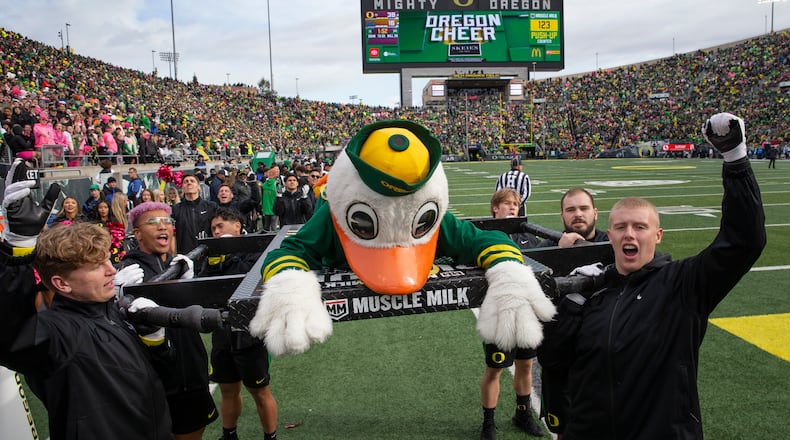With every league member set to be in Indianapolis this week for the league’s annual Football Media Days, here are 10 things you need to know about the new 18-team Big Ten:
1. Change is not new, but the league has never added this many teams at once.
The University of Chicago, Illinois, Minnesota, Northwestern, Purdue, Wisconsin and Michigan came together to form a new conference in 1896.
It grew to 10 teams with the addition of Indiana, Iowa and Ohio State then expanded again with Michigan State in the 1950s (after Chicago de-emphasized sports and left in the ‘40s). Penn State joined in early ‘90s followed by Nebraska in 2011 and Maryland and Rutgers in 2014.
2. The old name might fit better now.
Because college football originated at Ivy League schools in the east (and East Coast newspapers still dominated the media landscape), what’s now known as the Big Ten was called the Western Conference in its early years.
That moniker might have confused fans of later decades, but there is a whole western wing now with USC, UCLA, Oregon and Washington becoming members this year.
3. New members means a new scheduling format.
Of course the league stopped playing a true round-robin schedule decades ago, but the old divisional alignments meant some teams (such as Ohio State and Iowa) faced each other relatively rarely.
To avoid that, the league will be using what it calls the “Flex Protect Plus” model for scheduling because it protects historic rivalries such as Ohio State-Michigan, Iowa-Wisconsin, Minnesota-Wisconsin, etc. while allowing every team to face each other at least twice in a five-year span.
On the flip side, some noteworthy competitive annual matchups such as Ohio State-Penn State will be played less frequently.
4. The conference championship game is changing, too.
Indianapolis will still host the title tilt this year as it has every season since the first one in 2011, but no longer will it be a matchup of division champions because there are no divisions.
The top two teams in the final standings (likely after multiple tiebreakers are applied) will meet to determine the winner of the Big Ten.
5. The new Big Ten hopes to get multiple teams into the expanded College Football Playoff every year.
As part of the CFP’s expansion to 12 teams this year, the six highest-rated conference champions get automatic bids, and the top four conference champs get byes in the first round. That means the Big Ten Championship Game will have a lot on the line even if it is a seemingly unnecessary rematch between teams that already proved themselves to be the two best in the conference and playoff-worthy.
6. The conference definitely got stronger.
A consensus preseason top 25 list assembled by Sporting News had seven Big Ten teams at least receiving votes: No. 2 Ohio State, No. 4 Oregon, No. 9 Michigan, No 10 Penn State, No. 23 USC with Washington and Iowa receiving votes.
That means the new additions doubled the strength of the league, at least by that measure.
ESPN’s SP+ analytical rankings agree with Ohio State No. 2 in preseason projections followed by Oregon (3), Michigan (6), Penn State (7), USC (21), Iowa (22), UCLA (26) and Wisconsin (27) in the top 30.
As I sat down to begin previewing the 2024 Ohio State football season, I had one big problem.
— Marcus Hartman (@marcushartman) July 15, 2024
Where to begin? https://t.co/SNXSly1xQX
7. Both teams that played in the national championship game in January are members now.
However, Michigan and Washington are both going to be led by new head coaches and trying to overcome heavy personnel losses.
With a talented defense still at his disposal and a knack for developing good offensive lines, Sherrone Moore figures to have an easier time getting his Wolverines back to the playoff than Jedd Fisch, whose Huskies were more reliant on a high-powered offense that lost everyone.
8. The conference could be more offensive this fall.
That means scoring more points not slinging more insults.
Oregon was second in the nation at 44.2 points per game last season while USC was right behind at No. 3, and SP+ projects both to have top five offenses this fall despite having to break in new quarterbacks.
They could immediately become the two best offenses in the Big Ten as Ohio State slipped to 44th in scoring last season but hopes to bounce back with new offensive coordinator Chip Kelly.
9. Defense is probably not going to stop being a strength.
Michigan, Ohio State, Penn State and Iowa finished 1-4 in the nation in scoring defense last season, and all four of those teams should be stout on that side of the ball again.
While USC and Washington struggled to stop teams, Oregon and UCLA were ninth and 14th, respectively, in points allowed last season so the newcomers should also boost this side of the ball.
10. Ohio State is the favorite per multiple preseason polls.
The Buckeyes received 21 of 27 first-place votes in a poll conducted by Cleveland.com, which took the place of the Big Ten’s official poll when the conference stopped doing one 14 years ago.
Oregon got six first-place votes and was the runaway No. 2 in the poll followed by Penn State, Michigan and Iowa in the top five.
USC came in sixth followed by Wisconsin, Nebraska, Rutgers and Washington.
Maryland ranked 11th followed by Minnesota, Illinois, Northwestern, UCLA, Michigan State and Indiana with Purdue voted 18th.
About the Author

